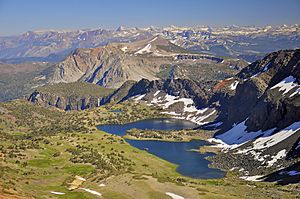Ansel Adams Wilderness facts for kids
Quick facts for kids Ansel Adams Wilderness |
|
|---|---|
|
IUCN Category Ib (Wilderness Area)
|
|

|
|
| Location | Madera / Fresno / Mono counties, California, USA |
| Nearest city | Fresno, CA |
| Area | 231,533 acres (936.98 km2) |
| Created | 1964 |
| Governing body | U.S. Forest Service |
The Ansel Adams Wilderness is a special protected area in California, USA. It is located in the beautiful Sierra Nevada mountain range. This wilderness covers a huge area of about 231,533 acres (93,698 hectares). A large part of it is in the Sierra National Forest. Another big part is in the Inyo National Forest. A small piece also covers nearly all of Devils Postpile National Monument. To the north, you'll find Yosemite National Park. The John Muir Wilderness is located to the south.
Contents
History of the Wilderness
This wilderness area was first created in 1964. It was part of the original Wilderness Act. At that time, it was called the Minarets Wilderness. The Minarets Wilderness was about 109,500 acres (44,313 hectares) big. It was formed by making the Mount Dana-Minarets Primitive Area larger and giving it a new name.
In 1984, the area was made even bigger. It was also renamed to honor Ansel Adams. He was a very famous environmentalist. Ansel Adams was also a well-known nature photographer. He is famous for his amazing black-and-white photos of the Sierra Nevada mountains.
Mountains and Rivers
The Ansel Adams Wilderness has many different elevations. It goes from about 3,500 feet (1,067 meters) up to 13,157 feet (4,010 meters). This area forms the northern part of the High Sierra.
The most important part of the wilderness is the Ritter Range. This range includes dark, rocky mountains. These mountains were shaped by glaciers. Some of the famous peaks here are Mount Ritter, Banner Peak, and The Minarets.
Just east of the Ritter Range is the Middle Fork of the San Joaquin River. This area includes Devils Postpile National Monument. Devils Postpile has tall, many-sided rock columns. These columns are made of basalt rock. Glaciers helped to reveal and smooth them. The Middle Fork of the river starts at Thousand Island Lake. This lake is at the base of Banner Peak. It is one of the biggest lakes in the Sierra backcountry.
East of the Middle Fork canyon is the main Sierra Crest. This part of the crest is lower than the Ritter Range. It is about 10,000 feet (3,048 meters) high. Because it's lower, winter storms can pass through easily. This brings a lot of snow to Mammoth Mountain. This gap also helps plants and animals move across the Sierra Crest.
West of the Ritter Range is the North Fork of the San Joaquin River canyon. This area is very remote and not visited often. The southern part of the wilderness has the main San Joaquin River. Its canyon is about 3,000 feet (914 meters) deep. The river flows out of the Sierra Nevada towards California's Central Valley.
Plants and Animals
The Ansel Adams Wilderness has large areas above the treeline. This means there are no trees growing there. The treeline is usually between 9,600 and 10,400 feet (2,926 to 3,170 meters). Above the treeline, you can find alpine meadows and rocky areas. There are also many lakes formed by glaciers. Below the treeline, the wilderness has different types of trees. These include lodgepole pine, red fir, and Jeffrey pine. The type of tree depends on the elevation.
Fun Activities
The wilderness has about 349 miles (562 kilometers) of hiking trails. Parts of the famous John Muir Trail and Pacific Crest Trail are here. The Sierra High Route is another path. It runs along the base of the Ritter Range. This route is for experienced hikers and is mostly off-trail.
The Middle Fork of the San Joaquin River gets the most visitors. In the summer, you need to take a bus to reach Devils Postpile. The bus leaves from the Mammoth Mountain Ski Area.
The Minarets mountains are a popular spot for rock climbing. People who like to climb rocks enjoy the challenging routes here.
In winter, you can go cross-country skiing. You can start your ski trips from both Mammoth Mountain and the June Mountain ski area.
Images for kids




